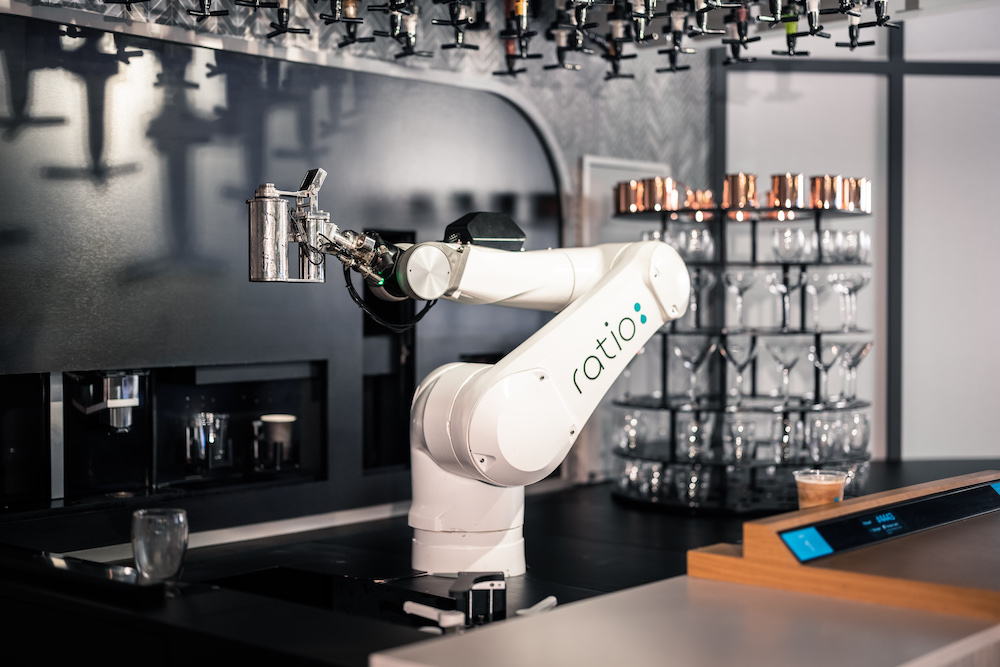
Will Robotics Help Save Food and Beverage Industry?
Over the years, Singapore restaurant owner Jerry Singh has been continuously trying to employ bartenders like others food and drinks operators.
Hiring a bartender needs him between two and six months. And, even though he finds one, the turnover is high.
We’re reliant on people who treat bartending as a career, but sad to say, not many Singaporeans treat this as a career. We’ve offered all kinds of bonuses, such as commitment bonuses in months four and seven. We dangle the carrots, and it still doesn’t offer any guarantee that the guy will stay.” - said Singh
That is why he is leveraging a robot bartender device named Ratio - created by Singaporean company Ross Digital - to mitigate the manpower shortage for his new restaurant in Seletar Aerospace Park.
In less than two minutes, this bartender will make a cocktail: the robotic arm takes up a drink or shaker, loads it with alcohol from the ceiling bottles, mixes it and slides it to the customer.

Ratio is a social robot, or cobot, designed to operate in public environments alongside humans.
And with the advent of this new robotics incarnation, some F&B players are hoping that there are ways it will support their ailing business.
Robots On Conserve Coffee Copitiam-Style?
Singaporean Gavin Pathross,CEO of Ross Digital, created ratio in 2018 because he saw a trend for automation in the F&B industry. Yesterday, November 2, the company formally unveiled its Ratio Robotic Cafe and Lounge at the Centrepoint.
Robots, he said, can be programmed to do the boring and what some people deem the "nobody really wants to do" dirty jobs, like cleaning dishes and flipping burgers.
Some robots, such as Ratio, can do more complicated work, including coffee making and cocktails, he said.
Mr. Pathross also thinks that robotics can theoretically help maintain coffee making in the kopitiam-style when no one else wants to make a living by making the S$1 cups of coffee that the old "tao chiew" (coffee brewers) now sell.
He had engineers working with many professional brewers to learn their craft and establish the authentic coffee style, so that Ratio could mimic what they are doing. “Through trial and error … we’ve managed to almost perfect it”, he said.
After a tasting session, managing director of Ebenezer Coffee Manufacturer Andrew Sim said Ratio's brew nearly matched the flavor of the usually brewed coffee.
To expect that such robots would take over the role of "tao chiew" in the future was enough for him. "The robot-made coffee will be very consistent while the ‘tao chiew’ coffee will be quite inconsistent".
Local startup Hawkermatic also introduced a computer earlier this year that can produce a smooth cup of kopitiam-style coffee after its maker, Jason Thai, couldn't find a professional brewer for his canteen-style coffee shop in one-north infinite studios.
Then there's a state of the art robotic barista Ella developed by the technology arm of Crown Group, Crown Digital. Now the company is looking to grow Ella's business reach in and outside Singapore.
It is also something Pathross aims to do to bring kopitiam-style coffee (Nanyang-style coffee) into foreign markets.
“We’ll take that technology overseas to Europe and the United States, where we can serve homesick Singaporeans (and) expose the Americans and Europeans to Nanyang coffee,” - he said
Effficiently Stable
According to Mr. Pathross, the use of robotics will also help reduce some of the costs in the F&B industry, which has been threatened tremendously by rents, salaries and product prices.
The cost of lease Ratio varies from S$2,500 to S$3,500 a month, which is equivalent to the average F&B staff salary, including bartenders.
“But what you get is about three to four times the efficiency, depending on how long you want the robot to work,” said Pathross, adding that a robot can work 24/7, has almost no downtime and “typically … doesn’t fall sick.
Robots are generally quite good in not wasting or making wrong drinks, which means (they) can reduce the cost of ingredients.”
A well-trained barista might make up to 60 cups of latte an hour, but he reckoned that a robot definitely doubles that.
Singh, whose monthly ratio lease includes kitchen appliances such as ice machines, chillers, and coffee devices, believes that the device would be more efficient and effective.
He met Pathross at a pop-up cafe-bar with this robotic bartender about a year ago in Shanghai and was persuaded that this invention will be able to help the F&B industry because “we’re cursed by manpower crunch issues”.
“There’s always that issue of unreliable staff and high turnover. The only way to eradicate it will be (automation), it’s almost impossible to find good, reliable bartenders to stay with you too. They’d want to move around.” - said Singh.
In reality, that's what Singh has planned for when its new restaurant, the Singapura Aerospace Club, opens this month: a bartender to look after his customers while Ratio makes the drinks in the background.
And who knows if this venture will grow into a Wild Robo Factory in the near future?





